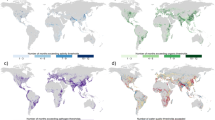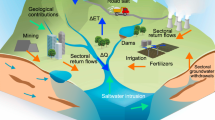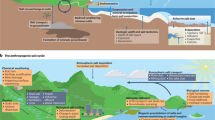Abstract
Inland freshwater salinity is rising worldwide, a phenomenon called the freshwater salinization syndrome (FSS). We investigate a potential conflict between managing the FSS and indirect potable reuse, the practice of augmenting water supplies through the addition of highly treated wastewater (reclaimed water) to surface waters and groundwaters. From time-series data collected over 25 years, we quantify the contributions of three salinity sources—a water reclamation facility and two rapidly urbanizing watersheds—to the rising concentration of sodium (a major ion associated with the FSS) in a regionally important drinking-water reservoir in the Mid-Atlantic United States. Sodium mass loading to the reservoir is primarily from watershed runoff during wet weather and reclaimed water during dry weather. Across all timescales evaluated, sodium concentration in the reclaimed water is higher than in outflow from the two watersheds. Sodium in reclaimed water originates from chemicals added during wastewater treatment, industrial and commercial discharges, human excretion and down-drain disposal of drinking water and sodium-rich household products. Thus, numerous opportunities exist to reduce the contribution of indirect potable reuse to sodium pollution at this site, and the FSS more generally. These efforts will require deliberative engagement with a diverse community of watershed stakeholders and careful consideration of the local political, social and environmental context.
This is a preview of subscription content, access via your institution
Access options
Access Nature and 54 other Nature Portfolio journals
Get Nature+, our best-value online-access subscription
$29.99 / 30 days
cancel any time
Subscribe to this journal
Receive 12 digital issues and online access to articles
$119.00 per year
only $9.92 per issue
Buy this article
- Purchase on Springer Link
- Instant access to full article PDF
Prices may be subject to local taxes which are calculated during checkout





Similar content being viewed by others
Data availability
All data used in this study are publicly available (https://doi.org/10.4211/hs.61a19724394643fca62a4fb3ce881efe).
Change history
28 July 2022
A Correction to this paper has been published: https://doi.org/10.1038/s41893-022-00948-y
References
Cañedo-Argüelles, M., Kefford, B. & Schäfer, R. Salt in freshwaters: causes, effects and prospects—introduction to the theme issue. Philos. Trans. R. Soc. Lond. B 374, 20180002 (2018).
Williams, W. D. Anthropogenic salinisation of inland waters. Hydrobiologia 466, 329–337 (2001).
Dugan, H. A. et al. Salting our freshwater lakes. Proc. Natl Acad. Sci. USA 114, 4453–4458 (2017).
Kaushal, S. S. et al. Increased salinization of fresh water in the northeastern United States. Proc. Natl Acad. Sci. USA 102, 13517–13520 (2005).
Stets, E. G. et al. Landscape drivers of dynamic change in water quality of US rivers. Environ. Sci. Technol. 54, 4336–4343 (2020).
Kaushal, S. S. et al. Freshwater salinization syndrome on a continental scale. Proc. Natl Acad. Sci. USA 115, E574–E583 (2018).
Bird, D. L., Groffman, P. M., Salice, C. J. & Moore, J. Steady-state land cover but non-steady-state major ion chemistry in urban streams. Environ. Sci. Technol. 52, 13015–13026 (2018).
Godwin, K., Hafner, S. & Buff, M. Long-term trends in sodium and chloride in the Mohawk River, New York: the effect of fifty years of road-salt application. Environ. Pollut. 124, 273–281 (2003).
Kelly, V. R. et al. Long-term sodium chloride retention in a rural watershed: legacy effects of road salt on streamwater concentration. Environ. Sci. Technol. 42, 410–415 (2008).
Overbo, A., Heger, S. & Gulliver, J. Evaluation of chloride contributions from major point and nonpoint sources in a northern U.S. state. Sci. Total Environ. 764, 144179 (2021).
Olson, J. R. Predicting combined effects of land use and climate change on river and stream salinity. Philos. Trans. R. Soc. Lond. B 374, 20180005 (2018).
Corsi, S. R., Cicco, L. A. D., Lutz, M. A. & Hirsch, R. M. River chloride trends in snow-affected urban watersheds: increasing concentrations outpace urban growth rate and are common among all seasons. Sci. Total Environ. 508, 488–497 (2015).
Kaushal, S. S. et al. Novel ‘chemical cocktails’ in inland waters are a consequence of the freshwater salinization syndrome. Philos. Trans. R. Soc. Lond. B 374, 20180017 (2018).
Moore, J., Fanelli, R. M. & Sekellick, A. J. High-frequency data reveal deicing salts drive elevated specific conductance and chloride along with pervasive and frequent exceedances of the US Environmental Protection Agency aquatic life criteria for chloride in urban streams. Environ. Sci. Technol. 54, 778–789 (2019).
Löfgren, S. The chemical effects of deicing salt on soil and stream water of five catchments in southeast Sweden. Water Air Soil Pollut. 130, 863–868 (2001).
Daley, M. L., Potter, J. D. & McDowell, W. H. Salinization of urbanizing New Hampshire streams and groundwater: effects of road salt and hydrologic variability. J. North Am. Benthol Soc. 28, 929–940 (2009).
Cooper, C. A., Mayer, P. M. & Faulkner, B. R. Effects of road salts on groundwater and surface water dynamics of sodium and chloride in an urban restored stream. Biogeochemistry 121, 149–166 (2014).
Snodgrass, J. W. et al. Influence of modern stormwater management practices on transport of road salt to surface waters. Environ. Sci. Technol. 51, 4165–4172 (2017).
International Stormwater BMP Database: 2020 Summary Statistics Project No. 4968 (The Water Research Foundation, 2020).
Venkatesan, A. K., Ahmad, S., Johnson, W. & Batista, J. R. Systems dynamic model to forecast salinity load to the Colorado River due to urbanization within the Las Vegas valley. Sci. Total Environ. 409, 2616–2625 (2011).
Steele, M. & Aitkenhead-Peterson, J. Long-term sodium and chloride surface water exports from the Dallas/Fort Worth region. Sci. Total Environ. 409, 3021–3032 (2011).
Davies, P. J., Wright, I. A., Jonasson, O. J. & Findlay, S. J. Impact of concrete and PVC pipes on urban water chemistry. Urban Water J. 7, 233–241 (2010).
Wright, I. A., Davies, P. J., Findlay, S. J. & Jonasson, O. J. A new type of water pollution: concrete drainage infrastructure and geochemical contamination of urban waters. Mar. Freshw. Res. 62, 1355–1361 (2011).
Moore, J., Bird, D. L., Dobbis, S. K. & Woodward, G. Nonpoint source contributions drive elevated major ion and dissolved inorganic carbon concentrations in urban watersheds. Environ. Sci. Technol. Lett. 4, 198–204 (2017).
Tippler, C., Wright, I. A., Davies, P. J. & Hanlon, A. The influence of concrete on the geochemical qualities of urban streams. Mar. Freshw. Res. 65, 1009–1017 (2014).
McLennan, S. M. Weathering and global denudation. J. Geol. 101, 295–303 (1993).
Wilkinson, B. H. Humans as geologic agents: a deep-time perspective. Geology 33, 161–164 (2005).
Schuler, M. S. et al. Regulations are needed to protect freshwater ecosystems from salinization. Philos. Trans. R. Soc. Lond. B 374, 20180019 (2018).
Haq, S., Kaushal, S. S. & Duan, S. Episodic salinization and freshwater salinization syndrome mobilize base cations, carbon, and nutrients to streams across urban regions. Biogeochemistry 141, 463–486 (2018).
Shanley, J. B. Effects of ion exchange on stream solute fluxes in a basin receiving highway deicing salts. J. Environ. Qual. 23, 977–986 (1994).
Hong, P. K. A. & Macauley, Y. Corrosion and leaching of copper tubing exposed to chlorinated drinking water. Water Air Soil Pollut. 108, 457–471 (1998).
Nguyen, C. K., Stone, K. R. & Edwards, M. A. Chloride-to-sulfate mass ratio: practical studies in galvanic corrosion of lead solder. J. Am. Water Works Assoc. 103, 81–92 (2011).
Stets, E., Lee, C., Lytle, D. & Schock, M. Increasing chloride in rivers of the conterminous US and linkages to potential corrosivity and lead action level exceedances in drinking water. Sci. Total Environ. 613-614, 1498–1509 (2018).
Dietrich, A. M. & Burlingame, G. A. Critical review and rethinking of USEPA secondary standards for maintaining organoleptic quality of drinking water. Environ. Sci. Technol. 49, 708–720 (2015).
Sodium in drinking water. In Guidelines for Drinking-Water Quality 2nd edn, Vol. 2, Health Criteria and Other Supporting Information (World Health Organization, 1996).
Drinking Water Advisory: Consumer Acceptability Advice and Health Effects Analysis on Sodium EPA 822-R-03-006 (EPA, 2003).
National Research Council Water Reuse: Potential for Expanding the Nation’s Water Supply Through Reuse of Municipal Wastewater (National Academies Press, 2012).
Mukherjee, M. & Jensen, O. Making water reuse safe: a comparative analysis of the development of regulation and technology uptake in the US and Australia. Saf. Sci. 121, 5–14 (2020).
EPA & CDM Smith 2017 Potable Reuse Compendium (EPA, 2017); https://www.epa.gov/sites/production/files/2018-01/documents/potablereusecompendium_3.pdf
Draft National Water Reuse Action Plan (EPA, 2019); https://www.epa.gov/waterreuse/draft-national-water-reuse-action-plan
Martin, B. & Via, S. Integrating water reuse into the US water supply portfolio. J. Am. Water Works Assoc. 112, 8–14 (2020).
Freshwater: Supply Concerns Continue, and Uncertainties Complicate Planning Technical Report GAO-14-43 (GAO, 2014); https://www.gao.gov/assets/670/663343.pdf
Rice, J. & Westerhoff, P. High levels of endocrine pollutants in US streams during low flow due to insufficient wastewater dilution. Nat. Geosci. 10, 587–591 (2017).
Wiener, M. J., Moreno, S., Jafvert, C. T. & Nies, L. F. Time series analysis of water use and indirect reuse within a HUC-4 basin (Wabash) over a nine year period. Sci. Total Environ. 738, 140221 (2020).
Harris-Lovett, S. & Sedlak, D. Protecting the sewershed. Science 369, 1429–1430 (2020).
Falconer, I. R., Chapman, H. F., Moore, M. R. & Ranmuthugala, G. Endocrine-disrupting compounds: a review of their challenge to sustainable and safe water supply and water reuse. Environ. Toxicol. 21, 181–191 (2006).
Novotny, E. V., Sander, A. R., Mohseni, O. & Stefan, H. G. Chloride ion transport and mass balance in a metropolitan area using road salt. Water Resour. Res. 45, W12410 (2009).
Potter, J. D., McDowell, W. H., Helton, A. M. & Daley, M. L. Incorporating urban infrastructure into biogeochemical assessment of urban tropical streams in Puerto Rico. Biogeochemistry 121, 271–286 (2013).
Kaushal, S. S. et al. Longitudinal patterns in carbon and nitrogen fluxes and stream metabolism along an urban watershed continuum. Biogeochemistry 121, 23–44 (2014).
Ambient Water Quality Criteria for Chloride Technical Report EPA 440/5-88-001 (EPA, 1998).
Nelsen, R. B. An Introduction to Copulas (Springer-Verlag, 2007).
Comprehensive Annual Financial Report (Upper Occoquan Service Authority, 2017); https://www.uosa.org/Documents/0450_012759.pdf
Tjandraatmadja, G. et al. Sources of Priority Contaminants in Domestic Wastewater: Contaminant Contribution from Household Products (CSIRO, 2008).
Schwabe, K., Nemati, M., Amin, R., Tran, Q. & Jassby, D. Unintended consequences of water conservation on the use of treated municipal wastewater. Nat. Sustain. 3, 628–635 (2020).
Cogswell, M. E. et al. Estimated 24-hour urinary sodium and potassium excretion in US adults. JAMA 319, 1209–1220 (2018).
Gleick, P. H. Global freshwater resources: soft-path solutions for the 21st century. Science 302, 1524–1528 (2003).
Grant, S. B. et al. Taking the “waste” out of “wastewater” for human water security and ecosystem sustainability. Science 337, 681–686 (2012).
Liu, C. et al. Robust slippery liquid-infused porous network surfaces for enhanced anti-icing/deicing performance. ACS Appl. Mater. Interfaces 12, 25471–25477 (2020).
Baldassarre, G. D. et al. Sociohydrology: scientific challenges in addressing the sustainable development goals. Water Resour. Res. 55, 6327–6355 (2019).
Su, J. G. et al. Factors influencing whether children walk to school. Health Place 22, 153–161 (2013).
Micron Announces Investment in Its Semiconductor Manufacturing Plant in Manassas, Virginia (Micron Technology, 2018); https://investors.micron.com/node/37386/pdf
Lazarova, V., Savoye, P., Janex, M. L., Blatchley, E. R. & Pommepuy, M. Advanced wastewater disinfection technologies: state of the art and perspectives. Water Sci. Technol. 40, 203–213 (1999).
Davis, M. L. Water and Wastewater Engineering: Design Principles and Practice (McGraw-Hill, 2010).
Rivera-Utrilla, J., Sánchez-Polo, M., Ferro-García, M. Á., Prados-Joya, G. & Ocampo-Pérez, R. Pharmaceuticals as emerging contaminants and their removal from water: a review. Chemosphere 93, 1268–1287 (2013).
Rauch, W. & Kleidorfer, M. Replace contamination, not the pipes. Science 345, 734–735 (2014).
Potts, J. The innovation deficit in public services: the curious problem of too much efficiency and not enough waste and failure. Innovation 11, 34–43 (2009).
McKenzie-Mohr, D., Lee, N. R. & Schultz, P. W. Social Marketing to Protect the Environment: What Works (Sage, 2011).
Calcagno, V. & de Mazancourt, C. glmulti: an R package for easy automated model selection with (generalized) linear models. J. Stat. Softw. 34, 1–29 (2010).
Schwarz, G. Estimating the dimension of a model. Ann. Stat. 6, 461–464 (1978).
Appling, A. P., Leon, M. C. & McDowell, W. H. Reducing bias and quantifying uncertainty in watershed flux estimates: the R package loadflex. Ecosphere 6, 269 (2015).
Madadgar, S., AghaKouchak, A., Farahmand, A. & Davis, S. J. Probabilistic estimates of drought impacts on agricultural production. Geophys. Res. Lett. 44, 7799–7807 (2017).
Sadegh, M., Ragno, E. & AghaKouchak, A. Multivariate copula analysis toolbox (MvCAT): describing dependence and underlying uncertainty using a Bayesian framework. Water Resour. Res. 53, 5166–5183 (2017).
Racine, J. & Hyndman, R. Using R to teach econometrics. J. Appl. Econom. 17, 175–189 (2002).
Acknowledgements
Funding was provided by a US National Science Foundation Growing Convergence Research (GCR) Program award to S.B.G., M.A.R., S.K., P.V., M.E., T.A.B. and T.S. (NSF award #2021015) and by a Metropolitan Washington Council of Governments award to S.B.G. and S.K. (contract #21-001). The authors thank the Upper Occoquan Service Authority—in particular, B. Angelotti and M. Noble-Blair—for providing critical data and guidance, H. Zhang at The Water Research Foundation for a national perspective on freshwater salinization, D. Sedlak for valuable comments on the manuscript and participants in the Occoquan Watershed Monitoring Lab’s Freshwater Salinization Workshop held on 14 January 2020.
Author information
Authors and Affiliations
Contributions
S.V.B. and S.B.G. conceived and drafted the article. E.A.P., M.A.R., A.N.G., P.V., A.M.-M., M.E., G.P., N.S. and S.C. contributed text and analysis. All authors contributed edits.
Corresponding author
Ethics declarations
Competing interests
The authors declare no competing interests.
Additional information
Peer review information Nature Sustainability thanks the anonymous reviewers for their contribution to the peer review of this work.
Publisher’s note Springer Nature remains neutral with regard to jurisdictional claims in published maps and institutional affiliations.
Supplementary information
Supplementary Information
Supplementary Tables 1–5, Note 1 and Figs. 1–3.
Rights and permissions
Springer Nature or its licensor holds exclusive rights to this article under a publishing agreement with the author(s) or other rightsholder(s); author self-archiving of the accepted manuscript version of this article is solely governed by the terms of such publishing agreement and applicable law.
About this article
Cite this article
Bhide, S.V., Grant, S.B., Parker, E.A. et al. Addressing the contribution of indirect potable reuse to inland freshwater salinization. Nat Sustain 4, 699–707 (2021). https://doi.org/10.1038/s41893-021-00713-7
Received:
Accepted:
Published:
Issue Date:
DOI: https://doi.org/10.1038/s41893-021-00713-7
This article is cited by
-
The anthropogenic salt cycle
Nature Reviews Earth & Environment (2023)
-
The recovery of European freshwater biodiversity has come to a halt
Nature (2023)



